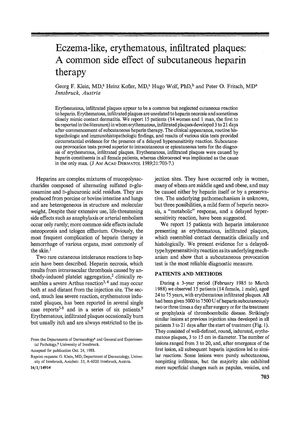Eczema-Like, Erythematous, Infiltrated Plaques: A Common Side Effect of Subcutaneous Heparin Therapy
October 1989
in “
Journal of The American Academy of Dermatology
”

TLDR Red, swollen skin patches are a common allergic reaction to heparin injections, and testing with different heparin types can help find a suitable treatment.
In the 1989 study by Klein et al., 15 patients (14 women and 1 man) developed erythematous, infiltrated plaques as a side effect of subcutaneous heparin therapy within 3 to 21 days of treatment initiation. These plaques, which resembled contact dermatitis and were not related to heparin necrosis, were identified as a delayed hypersensitivity reaction to heparin or its constituents. Subcutaneous provocation tests were more reliable for diagnosis than other methods. The study found that all female patients reacted to heparin constituents, while the male patient reacted to chlorocresol. The researchers concluded that these plaques are likely a delayed-type hypersensitivity reaction to heparin and that subcutaneous provocation is a reliable diagnostic tool. They recommended that patients with such reactions should be tested with different low molecular weight heparin preparations before resuming treatment.


